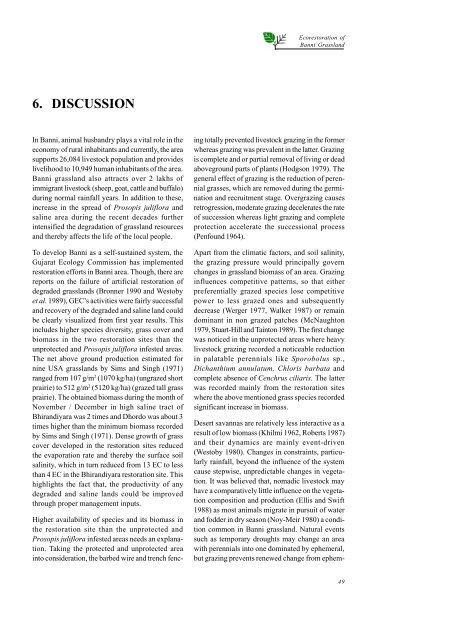Ecorestoration of Banni Grassland - Global Restoration Network
Ecorestoration of Banni Grassland - Global Restoration Network
Ecorestoration of Banni Grassland - Global Restoration Network
Create successful ePaper yourself
Turn your PDF publications into a flip-book with our unique Google optimized e-Paper software.
6. DISCUSSION<br />
In <strong>Banni</strong>, animal husbandry plays a vital role in the<br />
economy <strong>of</strong> rural inhabitants and currently, the area<br />
supports 26,084 livestock population and provides<br />
livelihood to 10,949 human inhabitants <strong>of</strong> the area.<br />
<strong>Banni</strong> grassland also attracts over 2 lakhs <strong>of</strong><br />
immigrant livestock (sheep, goat, cattle and buffalo)<br />
during normal rainfall years. In addition to these,<br />
increase in the spread <strong>of</strong> Prosopis juliflora and<br />
saline area during the recent decades further<br />
intensified the degradation <strong>of</strong> grassland resources<br />
and thereby affects the life <strong>of</strong> the local people.<br />
To develop <strong>Banni</strong> as a self-sustained system, the<br />
Gujarat Ecology Commission has implemented<br />
restoration efforts in <strong>Banni</strong> area. Though, there are<br />
reports on the failure <strong>of</strong> artificial restoration <strong>of</strong><br />
degraded grasslands (Bronner 1990 and Westoby<br />
et al. 1989), GEC’s activities were fairly successful<br />
and recovery <strong>of</strong> the degraded and saline land could<br />
be clearly visualized from first year results. This<br />
includes higher species diversity, grass cover and<br />
biomass in the two restoration sites than the<br />
unprotected and Prosopis juliflora infested areas.<br />
The net above ground production estimated for<br />
nine USA grasslands by Sims and Singh (1971)<br />
ranged from 107 g/m 2 (1070 kg/ha) (ungrazed short<br />
prairie) to 512 g/m 2 (5120 kg/ha) (grazed tall grass<br />
prairie). The obtained biomass during the month <strong>of</strong><br />
November / December in high saline tract <strong>of</strong><br />
Bhirandiyara was 2 times and Dhordo was about 3<br />
times higher than the minimum biomass recorded<br />
by Sims and Singh (1971). Dense growth <strong>of</strong> grass<br />
cover developed in the restoration sites reduced<br />
the evaporation rate and thereby the surface soil<br />
salinity, which in turn reduced from 13 EC to less<br />
than 4 EC in the Bhirandiyara restoration site. This<br />
highlights the fact that, the productivity <strong>of</strong> any<br />
degraded and saline lands could be improved<br />
through proper management inputs.<br />
Higher availability <strong>of</strong> species and its biomass in<br />
the restoration site than the unprotected and<br />
Prosopis juliflora infested areas needs an explanation.<br />
Taking the protected and unprotected area<br />
into consideration, the barbed wire and trench fenc-<br />
<strong>Ecorestoration</strong> <strong>of</strong><br />
<strong>Banni</strong> <strong>Grassland</strong><br />
ing totally prevented livestock grazing in the former<br />
whereas grazing was prevalent in the latter. Grazing<br />
is complete and or partial removal <strong>of</strong> living or dead<br />
aboveground parts <strong>of</strong> plants (Hodgson 1979). The<br />
general effect <strong>of</strong> grazing is the reduction <strong>of</strong> perennial<br />
grasses, which are removed during the germination<br />
and recruitment stage. Overgrazing causes<br />
retrogression, moderate grazing decelerates the rate<br />
<strong>of</strong> succession whereas light grazing and complete<br />
protection accelerate the successional process<br />
(Penfound 1964).<br />
Apart from the climatic factors, and soil salinity,<br />
the grazing pressure would principally govern<br />
changes in grassland biomass <strong>of</strong> an area. Grazing<br />
influences competitive patterns, so that either<br />
preferentially grazed species lose competitive<br />
power to less grazed ones and subsequently<br />
decrease (Werger 1977, Walker 1987) or remain<br />
dominant in non grazed patches (McNaughton<br />
1979, Stuart-Hill and Tainton 1989). The first change<br />
was noticed in the unprotected areas where heavy<br />
livestock grazing recorded a noticeable reduction<br />
in palatable perennials like Sporobolus sp.,<br />
Dichanthium annulatum, Chloris barbata and<br />
complete absence <strong>of</strong> Cenchrus ciliaris. The latter<br />
was recorded mainly from the restoration sites<br />
where the above mentioned grass species recorded<br />
significant increase in biomass.<br />
Desert savannas are relatively less interactive as a<br />
result <strong>of</strong> low biomass (Khilmi 1962, Roberts 1987)<br />
and their dynamics are mainly event-driven<br />
(Westoby 1980). Changes in constraints, particularly<br />
rainfall, beyond the influence <strong>of</strong> the system<br />
cause stepwise, unpredictable changes in vegetation.<br />
It was believed that, nomadic livestock may<br />
have a comparatively little influence on the vegetation<br />
composition and production (Ellis and Swift<br />
1988) as most animals migrate in pursuit <strong>of</strong> water<br />
and fodder in dry season (Noy-Meir 1980) a condition<br />
common in <strong>Banni</strong> grassland. Natural events<br />
such as temporary droughts may change an area<br />
with perennials into one dominated by ephemeral,<br />
but grazing prevents renewed change from ephem-<br />
49

















